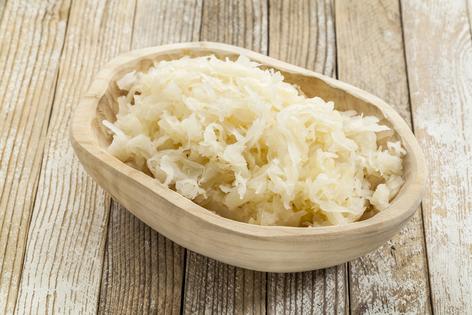Environmental Nutrition: There’s something about sauerkraut
“Sauerkraut” is simply the German word for sour cabbage.
The folklore
Although sauerkraut is considered to be a national dish of Germany, and has been a staple of the German diet since the 1600s, it didn’t originate in Germany. It is believed to have originated in China and was then brought to Europe. Originally, sauerkraut was fermented with rice wine, but once in Europe it was pickled with salt.
The facts
Sauerkraut is made from shredded cabbage combined with salt, which is then left to ferment. The salt draws out the juices, which ferment and produce lactic acid, creating its characteristic sour flavor. It is low in calories and very high in sodium. It is widely consumed in Eastern Europe and Asia today, though it’s not as popular in the U.S. Americans consume only about one-and-a-half pounds of sauerkraut per person per year. Most sauerkraut today is canned, which tastes quite different from sauerkraut made from scratch. Sauerkraut can be quite high in histamines, which should be avoided by anyone taking monoamine oxidase inhibitors, which include medications for depression and anxiety disorders.
The findings
Cabbage is a naturally rich source of phenolic compounds that have anti-inflammatory, antioxidant, and cancer-protective properties. (Molecules, 2010) Sauerkraut is also a rich source of lactic acid bacteria, which may help to boost the immune system and improve gut health. (Nutrients, 2021) There are few human studies that examine the health benefits of sauerkraut, but one small study found that among people with irritable bowel syndrome, consuming sauerkraut significantly improved symptoms. (Food and Function, 2018)
The finer points
Canned sauerkraut is familiar to most, but fresh sauerkraut can easily be made at home. Any number of sauerkraut recipes are available online. After all the ingredients are combined, it takes about three weeks or so for the cabbage to ferment. It can then be flavored with caraway, apples, cumin or coriander, to name a few options. Sauerkraut can be served with pork, sausages, beef, goose, duck and game birds, but sauerkraut on hot dogs is probably the most common combination found in the U.S.
(Environmental Nutrition is the award-winning independent newsletter written by nutrition experts dedicated to providing readers up-to-date, accurate information about health and nutrition in clear, concise English. For more information, visit www.environmentalnutrition.com.)
©2024 Belvoir Media Group, LLC. Distributed by Tribune Content Agency, LLC.







